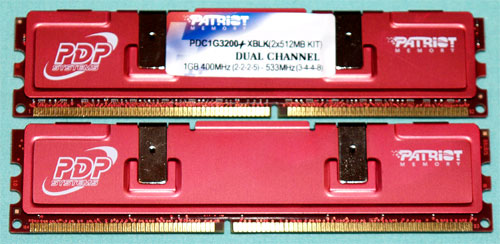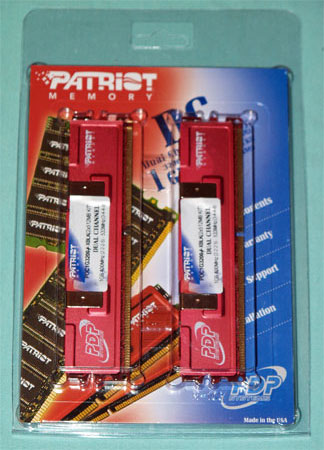Patriot DDR400 2-2-2/DDR533 3-4-4: Performance AND Value
by Wesley Fink on April 8, 2005 12:05 AM EST- Posted in
- Memory
Patriot PC3200+XBLK
PDP Systems (www.pdpsys.com) and the Patriot brand will be a new name for some readers. However, Patriot memory has been a line at Fry's/Outpost in the past and it is also available at New Egg and other web resellers. PDP Systems was founded in California's Silicon Valley in 1985. They have manufactured memory products for the past 14 years and they are also a member of Jedec, which is the memory industry standards organization. PDP currently markets a full line of DDR and DDR2 memory products, flash memory, and ATI video cards. On a global basis, PDP has two distribution centers in California, a Mid-West sales office, a Hong Kong sales/purchasing office and a Taiwanese purchasing affiliate.

Patriot PC3200+XBLK Specifications
Recognizing the extremely wide performance range of TCCD memory, PDP rates the memory at both DDR400 2-2-2-5 and DDR533 3-4-4-8. According to Patriot, the memory is tested in production at both specifications to ensure consistent performance.| Patriot PC3200+XLBK (DDR400/533) Memory Specifications | |
| Number of DIMMs & Banks | 2 DS |
| DIMM Size Total Memory |
512 MB |
| Rated Timings | 2-2-2-5 at DDR400 3-4-4-8 at DDR533 |
| SPD (Auto) Timings | 2-3-2-5 |
| Rated Voltage | 2.6V |
The XBL designation apparently signifies "eXtended Bandwidth and Latency". In the case of Samsung TCCD on a Brainpower PCB, this is certainly an apt description.
With Intel's introduction last summer of the Intel 915/925X chipsets with support for DDR2 memory, the primary market for DDR memory has become the excellent AMD Athlon 64 platform. However, some 915 boards also support DDR, and the continuing Intel Socket 478 also supports DDR memory. For these reasons, Patriot PC3200+XBLK was only tested on the DFI LANParty nF4 SLI-DR Athlon 64 Socket 939 test bed. This is the test bed that we recently used in evaluating OCZ VX memory in OCZ VX Revisited: DDR Updates on DFI nForce4.










23 Comments
View All Comments
sphinx - Friday, April 8, 2005 - link
Great article. But, how well does it perform against Kingston.overclockingoodness - Friday, April 8, 2005 - link
#10: While I understand how that may be useful in certain articles, I think it would only delay the time of the article. I bet it already takes AnandTech quite a bit of time to produce each article and when they start to add this "Dual-Core" section, I don't think it will really work out.Besides, it would start to get pretty annoying after a while. They might as well do a short piece on memory and how it effects dual-core. A seperate article may be cool, but I don't think I would want a dual-core section in memory reviews or anything else.
mariush - Friday, April 8, 2005 - link
Something is wrong here ( page 4 )While maintaining a constant CPU Speed of 2.4GHz, we measured the impact of increasing the Memory Speed from 200 to 300, a 50% increase. Memory Write performance increased about 29% with this 50% speed increase, while Memory Write performance improved by just 17%.
Determinant - Friday, April 8, 2005 - link
Hey guys (AnandTech staff),Just want to say that I've recently been really impressed with the quality and thought that goes into your articles.
I have a suggestion; Now that dual cores are upon us, I think that it would be a really good idea to have a new section in each article. The new section would show how the current product being tested allows for more functionality.
I'll explain: For example, a lot of people have been complaining about the dual core benchmarks saying that it isn't how they use their computer but that's because they have adapted to a single core environment. Alot of people (me included) turn off antivirus & spyware checkers etc when playing a game not because they want to but because it affects their gaming experience.
So, for example, in memmory reviews, I don't know if memmory affects the functionality on a dual core system (eg. does this faster memmory also allow me to listen to mp3's while gaming)
Me personally, I will purchase a dual core cpu not because it improves the performance of my current application but only because it allows me to have increased funcionality, less hassle, and a more enjoyable experience (I won't have to worry about stopping my antivirus when going into a game). Of course, more speed is always welcome.
If interested, I can provide examples of functionality that I would be interested in (eg. things that I would like to be able to accomplish with my computer).
Cheers.
mongoosesRawesome - Friday, April 8, 2005 - link
Considering how depending memory performance is on the actual speed of the CPU for Athlon64 systems, it would seem to me that people should be buying relatively cheap PC3200 Cas 2 ram and running with a divider. You can easily reach 90 percent of the performance without having to use 1:1 divider, as long as your divider and multiplier allow you to reach the same CPU speeds.Currently at newegg.com PC3200 CAS 2-3-2-5 T1 http://www.newegg.com/app/ViewProductDesc.asp?desc...
Also - "As you can see in the photo, there are just 8 small components in a row just above the gold connectors. Other boards for TCCD memory have many more components in this row. " Maybe its just me, but I can't see what you are trying to point out in the small picture. Maybe if you linked to the full size pic?
Wesley Fink - Friday, April 8, 2005 - link
#1 - Supposedly the memory controller runs at the same voltage as the CPU, since it is part of the CPU on the Athlon 64. The memory itself is what runs at 3.3V with VX, and it warranted to 3.5V by OCZ. The fate of the memory controller would therfore be dependent on the voltage used for the CPU. We rarely use more than 1.55V with a CPU with a default of 1.5V.#4 - The testing is complete for a Value RAM roundup which will appear next week.
#6 - Corrected.
#7 - We have not tested the TwinMOS with the same chips used in OCZ VX, but we have included OCZ Value VX in our upcoming Value RAM Rounup. It costs about $115 for a Gigabyte (2x512) and is made from Winbond UTT chips that have not been binned - like the TwinMOS. You will see how it performs in our Value RAM Roundup.
n yusef - Friday, April 8, 2005 - link
Great article. You guys need to do an article on the new TwinMOS value RAM with the (is Bh-5 or UTT, I forget) Winbond chips though.JustAnAverageGuy - Friday, April 8, 2005 - link
Page 3:The website is http://www.lavalys.com/ not http://www.lavasys.com/
Shinei - Friday, April 8, 2005 - link
Man, DDR630 at reasonable timings... Looks like another nail in DDR2's coffin. I wonder if the RAM could be coerced to tighten up its timings if one was to feed it 3.0 or 3.1 volts instead of 2.9v...JustAnAverageGuy - Friday, April 8, 2005 - link
Still waiting for a comparison against value memory :P